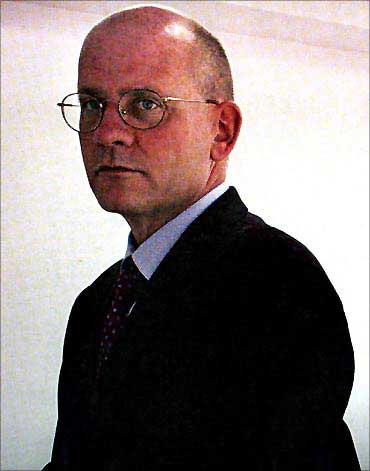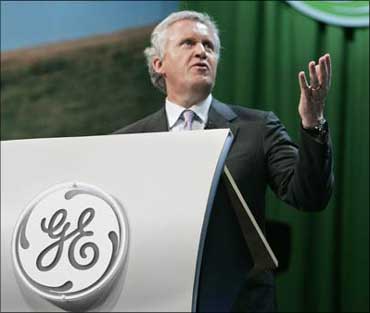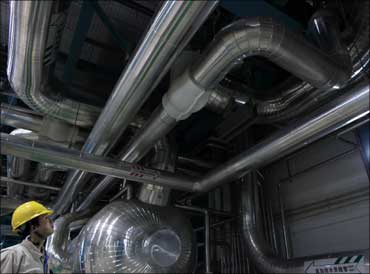Photographs: Courtesy, Business Standard Bhupesh Bhandari
Till recently, General Electric honchos would often talk of a turnover of $8 billion in India by 2010. This was 16 per cent of the company's projected emerging market business for the year.
At that time, GE hoped to sell gas turbines, consumer loans, water treatment plants, medical equipment et al in large numbers; hence the ambitious target. GE had ended 2008 with $2.8 billion. So, will it hit $8 billion when the books are closed for the year? The day of reckoning is almost here.
GE India President & CEO John Flannery says the company no longer discloses numbers for one country alone. So it's difficult to get him to comment if GE is on course to reach that size. But he does indicate that the target may have been ambitious.
"There is no shortage of opportunities in India, and there is a good fit to become two or three times the size we are today. That puts us somewhere close to the number you are poking at," says he. "Some of those things were aspirational, an attempt to get the organisation excited."
In his letter to shareowners in the 2009 annual report, GE chairman of the board and chief executive Jeffrey Immelt had said that GE had a $38-billion business in growth markets, which include resource- and people-rich regions like West Asia, Latin America, China and India.
"We sought out pockets of growth wherever we could find them. We deepened our position in fast-growing markets in Australia, Brazil, China and India."
That GE may have fallen short of its target for India does not mean that GE hasn't tasted success in India. It ran a hugely successful business process outsourcing outfit, Gecis, till 2004 when it was sold to General Atlantic Partners and Oak Hill Capital Partners for almost $500 million.
. . .
How General Electric plans to use Indian skills to grow
Image: Former GE chief John F Welch.Photographs: Reuters
The John F Welch Technology Centre in Bangalore, which was inaugurated in September 2000, has helped GE cut drastically go-to-market time (up to 50 per cent in some cases), save huge amounts of money and develop products for world markets. No estimates of the benefits are publicly available.
Bangalore is a cost centre for GE, into which it has so far invested $175 million. It has four partnerships going in India with state-owned Bharat Heavy Electricals Corporation, State Bank of India, Wipro and now Triveni Engineering. And it is very much in the reckoning for the Indian Air Force's order for 126 fighter jets.
But there have been serious reverses too. GE Capital had taken a huge exposure to unsecured loans and delinquencies were high. It so much wanted to invest in a diesel locomotive factory in the country; but right before the general elections last year, the government scrapped the bids and decided to put up the factory on its own.
The GE gas turbines at the Dabhol power plant of Ratnagiri Gas & Power broke down. Nuclear power is another huge opportunity (GE was one of the most vocal supporters of the Indo-US civilian nuclear deal), but nobody knows when it will start rolling.
Then TPS Chopra, the successor of GE's first CEO in India, Scott Bayman (he drove GE in India for ten long years), left last year. Chopra would often complain of the slow pace of affairs in India.
Clearly, things haven't gone the way they were intended. How much has that deterred GE? "We are very proud of what we have accomplished so far in India. Are we satisfied with where we are? No, we have still higher aspirations," says Flannery.
"We are here for the long haul. We will make major investments. We are going to do what it takes to win in India. Some things have balanced favourably, some unfavourably. That's not uncommon in a developing economy."
. . .
How General Electric plans to use Indian skills to grow
Image: GE chairman of the board and chief executive Jeffrey Immelt.Photographs: Reuters
The task ahead
Flannery brings with him considerable experience. A 1983 graduate of Fairfield University and an MBA from the Wharton School at the University of Pennsylvania, he has spent 22 years in GE. Before he moved to India, he was president & CEO of GE Capital for Asia Pacific.
His brief, before he winged his way to India in January, from Immelt was three-fold: Grow GE's presence in multiple dimensions, localise it and transform the organisation for the long haul. Flannery doesn't like to call it Plan B -- it is more like revised Plan A, says he.
The macroeconomic opportunity in India still excites GE. The opportunities in GE's core areas of infrastructure (power, railway, water treatment and so on), oil & gas and finance continue to remain huge.
"These (growth) markets are investing trillions of dollars in infrastructure and favour a multi-business company that can bring solutions. This allows us to form a 'company-to-country' approach in countries where government and business work together to solve infrastructure needs," Immelt had said in his letter to shareowners.
Flannery's first step has been to change GE's reporting structures in India. Ever since GE set up shop in India, all the business lines reported to their global business headquarters. As a result, they didn't have a reporting relationship with the Indian CEO.
What it meant was that GE's business in India was not looked as a single profit & loss centre. Key decisions on products, distribution and investments were taken outside India. The results, as a consequence, were less than desired.
All management thinkers have stressed the need for multinational corporations to think local. Those who listened carefully to the Indian customer have gained immensely; those who didn't have failed miserably.
. . .
How General Electric plans to use Indian skills to grow
Image: Water vapour builds up around a GE-powered F/A-18F Super Hornet as it breaks the sound barrier.Photographs: Reuters
The success of LG and Samsung of Korea and Suzuki of Japan can largely be attributed to strong local product development, manufacturing and distribution. All of them empowered their local employees to take important decisions. GE now is a standalone profit & loss account in India. Business lines all report directly to Flannery.
"I will be able to control the vast majority of decision-making," says he. In fact, the buzz in the market place is that the Bangalore technology centre too may become a part of the integrated Indian operations soon.
This will help GE go to a customer with more than one product. Till recently, various GE teams often made separate sales pitches to the same customer. Flannery admits this can often become very frustrating for the customer.
With integrated operations, GE will be able to present a unified face to the customer. "It also gives us more scale and critical mass, creates better jobs and career opportunities. The company with the best team on the field ends up number one or number two," says Flannery.
But he stresses that India will still stay very closely connected to GE's international business: "The centre of gravity will be India, but we are not seceding from the company. We will get the best from GE. It has the history of evolving as the markets change. The hallmark of the company is constant evolution."
Go local
That taken care of, Flannery wants to localise GE's business. This means sending people out to the market to gather what products and services are required, designing and manufacturing those products in India, and finally distributing them in India.
The first is on track, says he. For design, Flannery plans to leverage the skill sets of the Bangalore technology centre. So far, it has focused on GE's global requirements. To save cost and time was the first brief to the centre. The business verticals for which this work is done are aviation (commercial aircraft engines), energy (oil and gas, power and water treatment), transportation (diesel locomotives and signal systems) and healthcare.
. . .
How General Electric plans to use Indian skills to grow
Image: A zoomed picture shows two surgeons performing an operation to implant an artificial heart valve.Photographs: Reuters
In addition, there is a 400-strong team which carries out work on "Blue Sky" technologies -- new substances, materials, nanotechnology and solutions.
The brief could now change. In addition to the work it is doing, it will work on products that could be relevant for India.
"The brief is changing as we speak in an incremental and supplemental way. It will continue to be a key base for GE's global operations; that won't stop. But we will add resources to go local; some resources may be shifted," says Flannery.
"For the past 18 months, there has been in-country, for-country team at work for India-specific products and designs." To be fair, some products developed at Bangalore have already found their way to the Indian market -- the electrocardiogram that weighs just 1.1 kg and costs around Rs 35,000, the low-cost baby warmer which sells for around Rs 150,000, for instance.
The next part of the jigsaw puzzle is local manufacturing. Here, Flannery wants to make use of frugal Indian manufacturing skills. Immelt had outlined the strategy in his letter.
"Our focus is on introducing more new products at more price points. We are driving management practices to capture new opportunities, called reverse innovation. Essentially, this takes a low-cost, emerging-market business model and translates it to the developed world," he had said.
"To this end, we have developed a full line of high-margin, low-cost healthcare devices, designed in China and India, and now marketed successfully in the developed world."
. . .
How General Electric plans to use Indian skills to grow
Image: Steam turbine.Photographs: Reuters
GE already has two manufacturing joint ventures in India with BHEL and Wipro; it has now signed a third one with Triveni for steam turbines. GE, says Flannery, found Triveni efficient in turbines of up to 30 MW. Its own strength is above 100 MW. So, the two have come together for turbines of 30 MW to 100 MW.
"If it works well, you'll have a new player in 30 MW to 100 MW with the best in technology and cost-competitiveness. We could distribute these turbines globally in the long term. That's where GE's distribution capability, global footprint and customer relationships would come in," says Flannery.
GE, of course, is impressed with Triveni's supply chain, production design and costs. It can deliver turbines at low price points. "Triveni can do reverse innovation. It, we observed, was consistently hitting price points lower than that of global manufacturers. We are not talking of a 5 or 10 per cent change in margins," says Flannery.
The prices could be 30 to 40 per cent below global prices, experts reckon. The reason for the tie-up is clear.
GE could do more such tie-ups with low-cost manufacturers in the days to come. "You will see more investments in supply chain and direct manufacturing capabilities. That can be green-field or partnerships or even acquisition of companies with a manufacturing footprint," says Flannery.
So far as a distribution network in the country is concerned, Flannery says he still needs to figure out how to go about it.
Ups and downs
A broad strategy is fine, but Flannery needs to look at individual businesses as well. In financial services, it was an open secret that GE Capital was stuck with huge delinquencies in its retail portfolio.
. . .
How General Electric plans to use Indian skills to grow
Image: People walk past a State Bank of India board in Mumbai.Photographs: Reuters
There was also talk in the market that GE Capital was looking for a buyer for its portfolio. Flannery admits there was a problem of delinquencies with unsecured retail loans. To deal with that, GE Capital has shrunk its retail loan book.
A part of its transportation finance portfolio was sold to Shriram Transport Finance Company in December last year. This, says Flannery, has brought down the delinquencies as well as the losses. "GE Capital became profitable in India for the first time in two years during the January to March 2010 quarter," says he.
Going ahead, Flannery has decided to focus on institutional finance in areas that tie up with GE's business. In other words, it could finance the purchase of turbines by power plants, water treatment equipment by factories and healthcare machines by hospitals. At the moment, this book is as small as that of retail finance.
"We aren't talking of big dollars at present," says Flannery. On the positive side, he adds that the partnership with SBI, India's largest lender, for credit cards is steady. "We would like to build on this relationship," says he, but does not give details.
There have been some positive developments on the railway business as well. Strained for resources, the Indian government has come round the view that it won't be such a good idea to put up the locomotive factory on its own. So, it has restarted the process to find a private investor. And this time the stakes are bigger: Not just diesel locomotive, it also wants an electric locomotive plant and another one to make spares for the two factories.
"We will take another crack at it. We will definitely restart our interest in the diesel locomotive factory and assess the other two; they look interesting as well," says Flannery. In the last round, GE had developed a prototype for the diesel locomotive in its Bangalore centre. So, it has a product ready to offer. Flannery says it is not certain if GE will return with the same prototype.
Power play
Power will be a tougher nut to crack. One, GE's strength is gas turbines, renewable energy (wind and so on) and nuclear power -- the gap in its portfolio is coal, which is 50 to 60 per cent of the market.
. . .
How General Electric plans to use Indian skills to grow
Image: File photo of the Dabhol power plant.Photographs: Reuters
"We will continue to look at ways to play in that," says Flannery. But he is convinced that the dependence on coal to generate power will decline over time. "Coal tends to be more commodity- and less technology-driven. We are trying to stay up on the technology curve. Coal tends to be a very basic technological and engineering undertaking. For environmental reasons, higher growth will be in other sectors of the energy space."
Two, there have been aggressive sales from China. So much so, local manufacturers of power equipment are lobbying hard with the government for protection in some form. Flannery feels GE still has an advantage over others.
"It's very important to look at the life-cycle cost of this equation. We have a very strong story there around technology and service offering. These are very long-lived assets."
Three, Dabhol was bad publicity for GE's turbines. Flannery says GE engineers have fixed the problem and all turbines at the power plant in Maharashtra are on stream. A service contract has been written for GE. And, adds he, Dabhol no longer crops up when GE executives make a sales pitch to power companies.
Four, the fate of nuclear power in India, which can be a huge opportunity for GE, still hangs in balance. Consensus is yet to emerge on the liabilities that could arise from a Chernobyl-like accident. Still, Flannery is convinced of the opportunity for GE in power; what also excites him about the business is that every order for turbines comes with regular revenues from maintenance contracts.
Jack Welch, GE's best-known CEO and Immelt's predecessor, had laid down the principle that the company ought to be amongst the top three players in every line of business in a market; it should exit any business where it is a laggard. It may not be the right time to put India through that test.
Flannery, on his part, says if he can grow the company, localise it and change its structure, his job will be done. "If I can do these three things, my bosses, I think, will be happy."










article